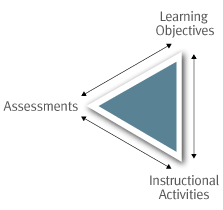Why should assessments, learning objectives, and instructional strategies be aligned?
 Assessments should reveal how well students have learned what we want them to learn while instruction ensures that they learn it. For this to occur, assessments, learning objectives, and instructional strategies need to be closely aligned so that they reinforce one another.
Assessments should reveal how well students have learned what we want them to learn while instruction ensures that they learn it. For this to occur, assessments, learning objectives, and instructional strategies need to be closely aligned so that they reinforce one another.
To ensure that these three components of your course are aligned, ask yourself the following questions:
- Learning objectives: What do I want students to know how to do when they leave this course?
- Assessments: What kinds of tasks will reveal whether students have achieved the learning objectives I have identified?
- Instructional strategies: What kinds of activities in and out of class will reinforce my learning objectives and prepare students for assessments?
What if the components of a course are misaligned?
If assessments are misaligned with learning objectives or instructional strategies, it can undermine both student motivation and learning. Consider these two scenarios:
Your objective is for students to learn to apply analytical skills, but your assessment measures only factual recall. Consequently, students hone their analytical skills and are frustrated that the exam does not measure what they learned.
Your assessment measures students’ ability to compare and critique the arguments of different authors, but your instructional strategies focus entirely on summarizing the arguments of different authors. Consequently, students do not learn or practice the skills of comparison and evaluation that will be assessed.
What do well-aligned assessments look like?
This table presents examples of the kinds of activities that can be used to assess different types of learning objectives (adapted from the revised Bloom’s Taxonomy).
| Type of learning objective | Examples of appropriate assessments |
|---|---|
| Recall Recognize Identify |
Objective test items such as fill-in-the-blank, matching, labeling, or multiple-choice questions that require students to:
|
| Interpret Exemplify Classify Summarize Infer Compare Explain |
Activities such as papers, exams, problem sets, class discussions, or concept maps that require students to:
|
| Apply Execute Implement |
Activities such as problem sets, performances, labs, prototyping, or simulations that require students to:
|
| Analyze Differentiate Organize Attribute |
Activities such as case studies, critiques, labs, papers, projects, debates, or concept maps that require students to:
|
| Evaluate Check Critique Assess |
Activities such as journals, diaries, critiques, problem sets, product reviews, or studies that require students to:
|
| Create Generate Plan Produce Design |
Activities such as research projects, musical compositions, performances, essays, business plans, website designs, or set designs that require students to:
|
This table does not list all possible examples of appropriate assessments. You can develop and use other assessments – just make sure that they align with your learning objectives and instructional strategies!
CONTACT US to talk with an Eberly colleague in person!